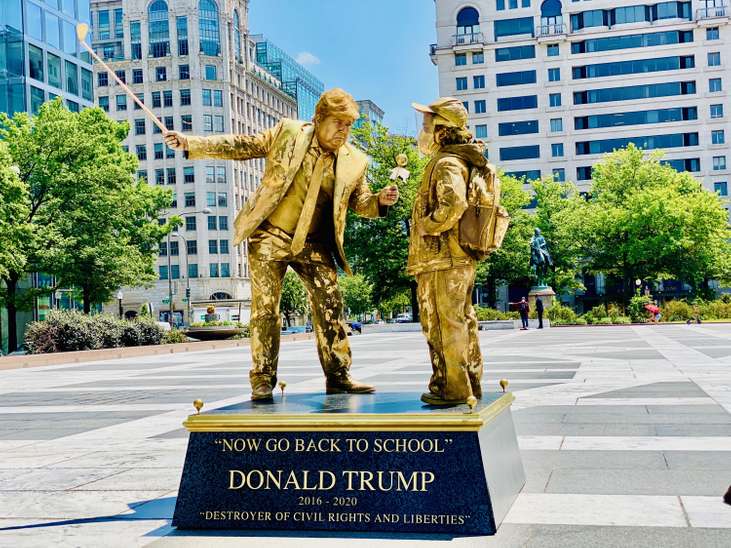
Big, shiny, gold statues of Donald Trump sound like they would be right up the president’s alley—but a new art project, titled the “Trump Statue Initiative,” uses the figures to instead memorialize his worst moments of 2020.
Street performers painted head-to-toe in metallic gold paint posed as still as stone atop massive plinths that hailed Trump as the “destroyer of civil rights and liberties.” The trio of “statues” appeared over the weekend in sites across Washington, DC.
Filmmaker Bryan Buckley decided to stage the project in part because of the way public statues have made headlines all summer, with activists outraging Trump with their efforts to remove memorials to Confederate leaders and other problematic historical figures. In response, the president has not only beefed up the law against vandalizing statues, but also issued an executive order to create a “National Garden of American Heroes.”
“I noticed that Trump was obsessed with statues,” Buckley told AdAge. “I felt like the best thing we could do was to create these very honest statues of the legacy he’s living right now, that let the world see exactly who he is.”
Bryan Buckley, The Bunker. Photo courtesy of the Trump Statue Initiative.
One work, titled Now Go Back to School, shows the president brandishing a golf club before a masked student, a critique of Trump’s insistence on in-person education this fall, despite the worsening outbreak in many parts of the country.
In The Bunker, Trump sits crosslegged on the floor, an homage to when the Secret Service whisked him away to a secure location inside the White House as Black Lives Matter demonstrations took place outside. (Trump later denied reports that he had been moved for his own protection.)
The third statue, The Poser, reenacts a scene from three days later, when riot police used force to clear protesters from outside the White House ahead of curfew, clearing a path from the presidential residence to St. John’s Episcopal Church. There, minutes later, Trump posed for a photo op holding a Bible.
One of the works was placed in front of the Trump Hotel, with the other two in Freedom Park, outside of the mayor’s office. During the installation, which lasted three or four hours in each location, violinist Celeste Vee was on hand to play songs by artists who have banned Trump from using them at his campaign rallies.
Bryan Buckley, Now Go Back to School. Photo courtesy of the Trump Statue Initiative.
Buckley is best known for creating television commercials—the New York Times once called them “tiny compressed films”—and he has been called “the King of the Super Bowl” for consistently making some of the most popular 30-second spots aired during football’s championship game.
For the “Trump Statue Initiative,” Buckley’s goal is to encourage citizens to vote for Joe Biden this November. He is working with Bradley Tusk of the campaign strategy firm Tusk Strategies on a series of events that will take place across the country between now and election day.
“We’re hoping with this initiative we will inspire other street performers, other artists to follow suit, whether across the country in swing states or conventions, that we really start to show these moments in statue form that show what we’ll be living with [if Trump wins reelection],” Buckley told the Hill. “The history he’s painting of himself right now, where his narcissistic or racist or self-serving moments abound, this is what he’s leaving us with.”